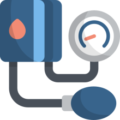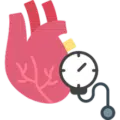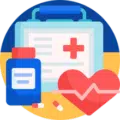Author(s)
Vicky Shah, PharmD, BCPS
Daniel Longyhore, PharmD, M.S., BCACP
Reviewed By
Austin Crocker, Pharm.D.
Lauren Bloodworth, Pharm.D., BCPS
Joseph Saseen, Pharm.D., BCPS, BCACP
“Silent killer,” which would be an amazing slasher movie title, is often used to describe hypertension – a disease that causes irreparable harm to the body with few (if any) physical symptoms. But hypertension is a leading cause of morbidity and mortality impacting one billion — yes, that’s billion with a “b” — patients worldwide.1 Although numerous treatment options are available, the majority of patients with high blood pressure are not well controlled due to a variety of reasons including low health literacy, less than optimal adherence to medications, and a lack of understanding it’s pathophysiology and consequences.2
Traditionally, the management of hypertension requires routine blood pressure checks by a health professional to adjust medications. Could self-monitoring lead to better outcomes? Would a greater percentage of patients achieve their goal blood pressure (BP)? Rates of self-monitoring vary throughout the world. In the United States, some studies have reported self-monitoring rates as high as 70% but this included any blood pressure check performed outside of the physician office (e.g. home, pharmacy, fire station, retail store, family member’s home, church, friend’s home). In the United Kingdom, BP self-monitoring rates are much lower (30%) likely due to differences in what is considered self-monitoring.3 Self-monitoring may be an efficient method to improve blood pressure control; however, results from published reports are inconsistent. The authors of the TASMINH4 study sought to compare the effectiveness of three different approaches to BP monitoring.4
The TASMINH4 study was an unblinded, parallel, controlled trial with patients randomly assigned (1:1:1) to one of three BP monitoring strategies: self-monitoring alone (patient records and sends readings via mail to physician), self-monitoring with telemonitoring (patient records and sends readings via email/app to physician), and usual care (all monitoring occurs in the physician’s office). Eligible patients were 35 years or older, diagnosed with hypertension, taking no more than three antihypertensive agents, had a blood pressure of greater than 140/90 mm Hg, stable on their antihypertensive regimen for at least the last 4 weeks, and did not have orthostatic hypotension.
All participants had a comprehensive medication review. Participants assigned to either of the two self-monitoring groups were taught to use an automated electronic sphygmomanometer (Omron M10-IT) and instructed to monitor their blood pressure twice each morning and evening during the first week of each month. Those in the self-monitoring and telemonitoring groups reported their blood pressures to physician practices. Physicians reviewed both self-monitoring and telemonitoring groups readings every month and antihypertensive medication changes were remotely communicated to patients. In the usual care group, medication titration was based on clinic blood pressure readings. The study was conducted in the United Kingdom at 142 general practice clinics, The goal blood pressure was 150/90 mm Hg based on the current guidelines from the National Institute for Health and Care Excellence (NICE) adjusted for self-monitoring.5 All participants were seen at 6 and 12 months by research nurses; however, physicians could make adjustments to medications at any time, regardless of which group a patient was assigned. The primary and secondary outcomes are listed in Table 1.
Table 1: Study Outcomes
|
Primary Outcome
Secondary Outcomes
|
More than 95% of the participants (n=1173) were of white descent in each treatment arm. Groups were similar in composition with a mean age of 66.9 years, slightly more males, mean baseline blood pressure of 153/86 mm Hg, and mean time since diagnosis of hypertension of approximately 10 years. After 12 months, mean systolic blood pressure was significantly lower in both self-monitoring groups when compared to usual care. See Table 2. However, there was no significant difference between the self-monitoring and telemonitoring groups (AMD -1.2 mm Hg | 95% CI -3.5 to 1.2; p=0.3219). There were no differences in diastolic blood pressure between groups at 6 or 12 months.
Table 2: Mean Systolic Blood Pressure at Baseline, 6 Months, and 12 Months
|
|
Telemonitoring Group |
Self-Monitoring Group |
Usual Care Group |
|
Baseline |
153.2 (14.3), n=389 |
152.9 (13.6), |
153.1 (14.0), n=393 |
|
6 Months |
139.0 (16.8), n=338 |
140.4 (15.7), |
142.5 (15.4), n=358 |
|
12 Months |
136.0 (16.1), n=327 |
137.0 (16.7), |
140.4 (16.5), n=348 |
|
6-month adjusted mean difference (95% CI, p value) vs. usual care |
-3.7 |
-2.1 |
— |
|
12-month adjusted mean difference (95% CI, p value) vs. usual care |
-4.7 |
-3.5 |
— |
Adverse events were similar among the three groups with no difference in side effects or anxiety. Cardiovascular events occurred in nine patients in the usual care group, 12 in the self-monitoring group, and 11 in the telemonitoring group. Although patients are being followed to observe morbidity and mortality rates, the study was not powered to assess the differences in these outcomes.
At the 12-month follow-up, the mean number of antihypertensive agents had increased slightly more in the self-monitoring and telemonitoring group compared to the usual group (0.27, 0.31, and 0.22 medications), but it is unlikely these differences are clinically meaningful. The addition of angiotensin-converting-enzyme inhibitors and angiotensin receptor blockers accounted for the majority of changes in medications. There was no difference in self-reported adherence rates between groups per the MARS questionnaire scores, nor was there any difference in weight, waist circumference, lifestyle factors, or quality of life scores between the groups.
The TASMINH4 trial showed that the use of a self-monitoring blood pressure management strategy, with or without telemonitoring, resulted in lower systolic blood pressure. The results should be viewed in light of existing research, which includes two previously published European studies with 12 month follow-up where physicians used self-monitored blood pressure readings to titrate antihypertensive agents.5–7 In both studies, those who participated in self-monitoring had higher blood pressure readings than those managed with usual care. However, all study groups demonstrated a drop in systolic blood pressure from baseline similar to that observed in TASMINH4. Current UK guidelines do not recommend the use of self-monitoring, but reserve the option for long-term management in patients experiencing white-coat hypertension.5 Conversely, the 2017 American College of Cardiology (ACC) / American Heart Association (AHA) Guideline for High Blood Pressure in Adults recommends self-monitoring and telehealth interventions.8
Strengths of the study include the large sample size, multicenter design, and well-matched baseline characteristics among the three arms.4 However, there are several limitations. Outcomes were measured only at 6 and 12 months — blood pressure control between these two time points are not reported. The study population, though large, was primarily Caucasian (British ancestry) which potentially limits the generalizability to other populations (and cultures). The inclusion criteria were very strict and do not match the general population as only patients with uncontrolled hypertension were included. Nearly half of the eligible participants were excluded because their BP was <140/90 at baseline. Thus, this intervention can only be applied to those who need an improvement in blood pressure control. Information was not provided regarding participants’ adherence to the study protocol or their ability to perform the blood pressure monitoring technique. Lastly, the BP goals in this study —150/90 mm Hg — are much higher than what current guidelines recommend.
The results of TASMIN4 suggest that patient self-monitoring can lead to lower BP readings, but only if practitioners use the information to adjust medications. With the publication of the most recent ACC/AHA guidelines released in November of 2017, millions more patients will be diagnosed with hypertension.8 This will burden an already taxed healthcare system. It is therefore paramount to find methods to empower patients to take greater control of monitoring their BP and to decrease the burden on health professionals. Should we empower patients to self-adjust their antihypertensive medications based on an algorithm similar to self-monitoring and adjusting insulin doses based on fingerstick glucose readings? Tell us what you think.
1. Danaei G, Finucane MM, Lin JK, et al. National, regional, and global trends in systolic blood pressure since 1980: systematic analysis of health examination surveys and epidemiological studies with 786 country-years and 5·4 million participants. The Lancet. 2011;377(9765):568-577. doi:10.1016/S0140-6736(10)62036-3
2. Glynn LG, Murphy AW, Smith SM, Schroeder K, Fahey T. Interventions used to improve control of blood pressure in patients with hypertension. Cochrane Database Syst Rev. 2010;(3):CD005182. doi:10.1002/14651858.CD005182.pub4
3. Breaux-Shropshire TL, Brown KC, Pryor ER, Maples EH. Prevalence of blood pressure self-monitoring, medication adherence, self-efficacy, stage of change, and blood pressure control among municipal workers with hypertension. Workplace Health Saf. 2012;60(6):265-271. doi:10.1177/216507991206000606
4. McManus RJ, Mant J, Franssen M, et al. Efficacy of self-monitored blood pressure, with or without telemonitoring, for titration of antihypertensive medication (TASMINH4): an unmasked randomised controlled trial. The Lancet. 2018;391(10124):949-959. doi:10.1016/S0140-6736(18)30309-X
5. National Institute for Health and Care Excellence. Hypertension in adults: diagnosis and management [CG127]. https://www.nice.org.uk/guidance/cg127. Published 2016. Accessed May 1, 2018.
6. Verberk WJ, Kroon AA, Lenders JWM, et al. Self-measurement of blood pressure at home reduces the need for antihypertensive drugs: a randomized, controlled trial. Hypertens Dallas Tex 1979. 2007;50(6):1019-1025. doi:10.1161/HYPERTENSIONAHA.107.094193
7. Staessen JA, Den Hond E, Celis H, et al. Antihypertensive treatment based on blood pressure measurement at home or in the physician’s office: a randomized controlled trial. JAMA. 2004;291(8):955-964. doi:10.1001/jama.291.8.955
8. Whelton PK, Carey RM, Aronow WS, et al. 2017 ACC/AHA/AAPA/ABC/ACPM/AGS/APhA/ASH/ASPC/NMA/PCNA Guideline for the Prevention, Detection, Evaluation, and Management of High Blood Pressure in Adults: Executive Summary: A Report of the American College of Cardiology/American Heart Association Task Force on Clinical Practice Guidelines. Hypertens. November 2017. doi:10.1161/HYP.0000000000000066






 iForumRx.org is a web-based community of practice designed to inform ambulatory care pharmacy specialists, pharmacy residents, and student pharmacists about high-quality, practice-changing evidence.
iForumRx.org is a web-based community of practice designed to inform ambulatory care pharmacy specialists, pharmacy residents, and student pharmacists about high-quality, practice-changing evidence.